Sauerkraut is not a word we hear regularly in the Caribbean as it is not typically part of our cuisine. If you are not familiar with it, sauerkraut is cultured or fermented cabbage.
The word ‘sauerkraut’ itself is a German word that literally translates to ‘sour cabbage’, however, it is believed that it originated with the Chinese who started fermenting cabbage in the 7th century BC.
So esteemed was this early ‘superfood’ known for being rich in vitamin C, that in 1768 Captain James Cook, a British navigator and explorer made certain to take it with him in abundance on his long sea voyage to prevent scurvy among his men.
Before the invention of refrigeration, fermenting fresh foods was a valuable form of preservation to extend shelf-life and reduce food spoilage and wastage. This has been practised for thousands of years among many cultures throughout the world. Today, this has given us foods such as:
- Kimchi from Korea
- Lassi from India (Dahee)
- Miso and Natto from Japan
- Garri from Africa
- Tempeh from Indonesia


In Trinidad and Tobago, other than yoghurt, dahee, which was brought to Trinidad and Tobago by East Indian indentured labourers, is a popular fermented food. There has also been a recent increase in local producers making probiotic drinks such as kombucha and kefir.
As far as I know, Haitian fermented Pikliz is probably the closest Caribbean dish to sauerkraut. It is similar to a blend of pepper sauce and fermented cabbage.
Why Eat Fermented Foods?
Hippocrates, the father of modern medicine is quoted as saying, “all diseases begin in the gut” and many studies are indeed proving that there is a connection between the risk of disease and gut health.
Beneficial bacteria in the gut or intestinal tract contribute greatly to our physical and mental health. They help keep ‘bad’ bacteria in check which have been shown to contribute to anxiety, depression, and overeating leading to obesity, among many other ails.
In addition, our lifestyles have changed so much from natural origins with the consumption of excess sugar and processed food, that the microbiome in the gut is imbalanced in many individuals. Adding fermented foods to our diets can introduce beneficial microbes into the intestinal tract to help keep harmful bacteria in check.
What Is Lacto-Fermentation?
Lacto-fermentation, the process used to make sauerkraut, is the process by which lactic acid bacteria, break down sugar into lactic acid and carbon dioxide.
To make sauerkraut, cabbage is shredded and between 2% to 3% salt (by weight) is added. The salt is squeezed and massaged into the cabbage to allow the cell walls to break for the cabbage to release its natural water. Also by osmosis, the water is drawn out of the cabbage to create a brine.
The salt content of the brine kills harmful microorganisms, while the lactic acid bacteria (mainly lactobacillus species) survive. The lactobacilli, which naturally live on the cabbage leaves, then convert the natural sugars in the cabbage into lactic acid and carbon dioxide. The salt hardens the pectins in the cabbage, giving it its crunchy texture while the acidity preserves it and gives it its tangy flavour. During fermentation, the sauerkraut becomes bubbly as carbon dioxide is created, but this usually stops when the acidity or pH of the sauerkraut reaches 3.5 or less; then the lactobacilli growth is inhibited and fermentation stops.
There are many benefits of sauerkraut;
- It is high in vitamin C, antioxidants and minerals
- It is packed with living probiotics that contribute to healthy digestive flora
- It is high in vitamin K2 that promotes healthy arteries
- It may contribute to weight loss due to being high in fibre and low in calories (27 calories per cup)
- It improves digestion due to a variety of enzymes it contains
- It improves immunity
- There is increased nutrient availability
Personally, I love the crunchy tangy flavour of sauerkraut in sandwiches, salads, burgers, as a side dish with foods like pelau, or sometimes I would just eat a spoonful when I’m feeling for ‘something salt to pass in mih mouth‘.
Typically, sauerkraut is just two ingredients – cabbage and salt – but you know the Trinbagonian in me will want to ‘Trinify’ the recipe. So I add seasonings to my sauerkraut. In the recipe below, I added, shadon beni (culantro), garlic and pimento peppers. This is totally optional as well as you can add your own spices according to your taste.
Salt
As mentioned previously, salt helps to create a favourable environment for the lactic acid bacteria and also prevents the growth of harmful microorganisms. The ideal amount of salt used for fermentation is 2.25% to 2.5% salt by weight or 1 1/2 to 2 teaspoons per pound of cabbage.
Avoid using salts high in fluoride and iodine as they may inhibit the fermentation process. Opt for unrefined high mineral salts such as pure sea salt or Himalayan pink salt. Also, avoid coarse salt, a finer grade will dissolve better in the brine.
This is the Himalayan pink salt that I used.
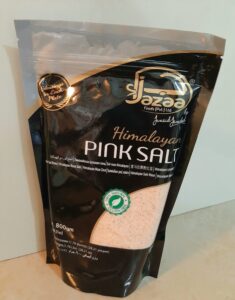
Choosing A Cabbage For Sauerkraut
When shopping for cabbage, choose a head that is firm with fresh, crisp leaves, not old or wilted. Good quality cabbage will yield good quality sauerkraut. It is best to seek out one that is free of pesticides or other chemicals.
For this recipe, I used three pounds of green cabbage (this was the weight after chopping and removing the stem).
Equipment
- Cutting board
- Knife
- Kitchen Scale
- Large Mason or Glass Jar
- Fermentation weights ( or marbles, stones)
- Small container (for leaves)
- Large container to mix cabbage
Ingredients
- 3 lbs of cabbage
- 6 tsp salt (sea or pink)
- 5 large shadon beni leaves (culantro)
- 1 head of garlic
- 4 pimento peppers
Directions to Make Sauerkraut
Always start with clean utensils and surfaces.
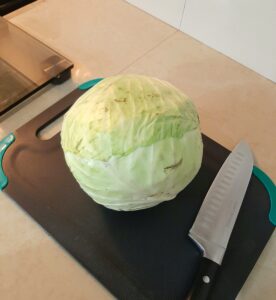
Remove the outer leaves of the cabbage. Rinse them thoroughly under running water and set them aside to drain for use later on.
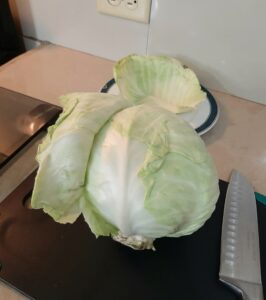
Prepare the cabbage by slicing or shredding. Discard the core (or put it in your next batch of bone broth.)
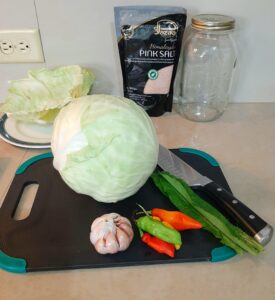
Chop or mince the pimentoes and chadon beni. I finely grated the garlic but it is also an option to chop all the seasonings in a food processor.
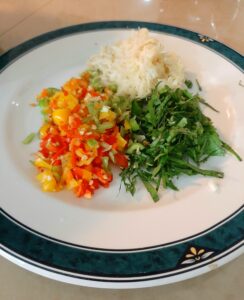
Measure out the salt.
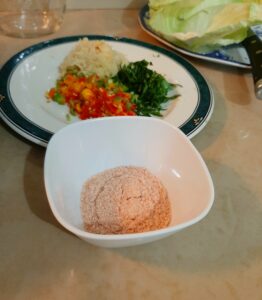
In a large container, add the chopped cabbage, seasonings and salt.
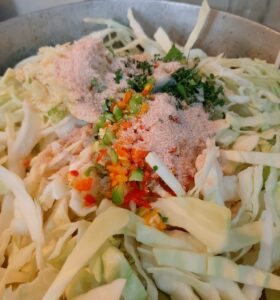
With clean hands, mix all the ingredients together while squeezing and massaging the salt into the cabbage for about 3 minutes. While doing this you want to crush or bruise the pieces of cabbage with your hands to break the cell walls and allow the natural water within to help create a brine. Next, cover it and allow it to rest for about half an hour.
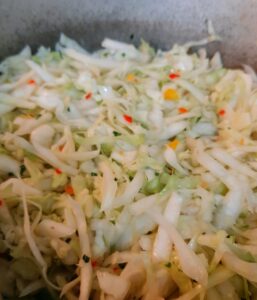
After allowing it to rest, transfer it to a mason or other glass jar and press it down into the jar. Include any liquid that was at the bottom of the mixing container. The brine will rise to the top. Ensure that the solids are fully submerged in the brine.
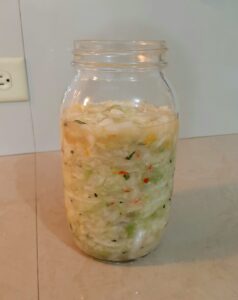
Put the clean reserved cabbage leaves on the top; push them into the brine.
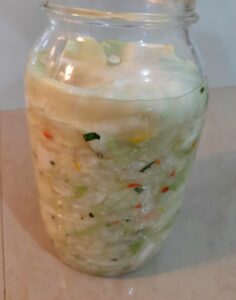
Next, use a weight to ensure that everything is well-submerged.
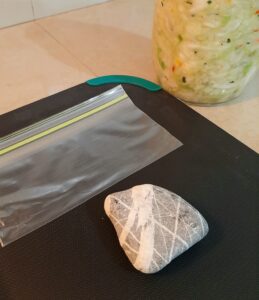
I didn’t have a fermentation weight so I improvised using a clean sanitized river rock in a sealed Ziploc bag.
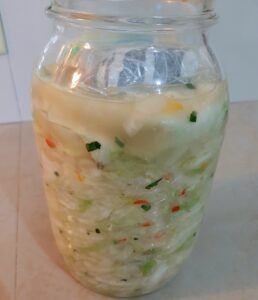
Leave at least 2 inches of head space between the brine and the lid and cover the jar loosely. Put the jar in a container should any of the fermenting brine bubble out. As the carbon dioxide is created during fermentation, bubbles can raise the sauerkraut to the top of the jar.
Store in an area away from direct light and heat, I like to put it in the kitchen cupboard.
Check on it every day. Ensure that the cabbage is submerged under the brine and open the lid to ‘burp’ it once a day to release some of the pressure created by the gas. Replace the lid on it immediately. If you need to use a utensil to push down the sauerkraut to re-submerge it, it is preferable to use a wooden or silicone spoon, avoid using metal.
Taste the sauerkraut as it ferments to find the flavour that you like as it becomes more sour the longer it ferments. I usually start tasting it after 3 days of fermentation. As the temperatures in everyone’s homes vary, fermentation may happen at different rates. For some, day 5 ferment may be the sweet spot, whereas, for others, day 12 might be best.
Once the flavour is where you like it, remove the weight and the cabbage leaves from the top of the sauerkraut, replace the lid and put it in the refrigerator. Fermentation slows down once placed in the fridge.
Sauerkraut kept in the fridge can last from 4 to 6 months. It usually finishes in my home long before that, as we love sauerkraut!
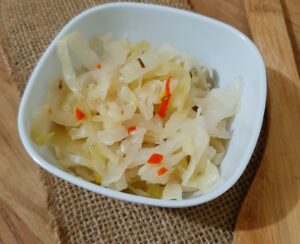
Since my journey into the world of homemade fermented foods, I have since made fermented garlic, cucumbers, carailie, sweet peppers and even fermented pepper sauce. It is a great way to preserve food especially when it is seasonally in abundance and at lower prices in the market. Not to mention all the valuable health benefits.
All-in-all I believe fermenting food at home is a valuable skill to have.
Homemade Sauerkraut
Equipment
- Cutting Board
- Container for leaves
- Knife
- Kitchen Scale
- Large container to mix cabbage
- Large Mason or Glass Jar
- Fermentation Weights or marbles or stones
Ingredients
- 3 lbs Cabbage
- 6 tsp Mineral Salt
- 5 large leaves Shadon Beni (Culantro)
- 1 head Garlic
- 4 whole Pimento Peppers
Instructions
- Remove the outer leaves of the cabbage. Rinse them thoroughly under running water and set them aside to drain for use later on.
- Prepare the cabbage by slicing or shredding. Discard the core (or put it in your next batch of bone broth.)
- Chop or mince the pimentoes and chadon beni. Finely grate the garlic or chop all the seasonings in a food processor.
- Measure out the salt.
- In a large container, add the chopped cabbage, seasonings and salt.
- With clean hands, mix all the ingredients together while squeezing and massaging the salt into the cabbage for about 3 minutes. While doing this you want to crush or bruise the pieces of cabbage with your hands to break the cell walls and allow the natural water within it to help create a brine. Next, cover it and allow it to rest for about half an hour.
- After the rest period, transfer to a mason or other glass jar and press it down into the jar. Be sure to include any liquid that was at the bottom of the mixing container. The brine will rise to the top. Ensure that the solids are fully submerged in the brine.
- Put the clean reserved cabbage leaves on the top; push them into the brine.
- Next, use a weight to ensure that everything is well-submerged. Leave at least 2 inches of head space between the brine and the cover and cover the jar loosely. Put the jar in a container in case any of the fermenting brine should bubble out.
- Store in an area away from direct light and heat.
- Check on it every day. Ensure that the cabbage is submerged under the brine and open the lid to 'burp' it once a day to release some of the pressure created by the gas. Replace the cover on it immediately. If you need to use a utensil to push down the sauerkraut to re-submerge it, it is preferable to use a wooden or silicone spoon.
- Taste it after 3 days of fermentation to find the flavour that you like as it becomes more sour the longer it ferments.
- Once the flavour is where you want it, remove the weight and the cabbage leaves from the top of the sauerkraut, replace the lid and put it in the refrigerator. Fermentation slows down once placed in the fridge. Sauerkraut kept in the fridge can last from 4 to 6 months.

